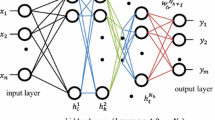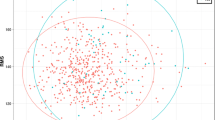Abstract
Birth asphyxia can result in death or permanent brain damage. To prevent it, the fetal heart rate (FHR) is recorded in labour on a paper strip. In clinical practice, the complicated FHR patterns are assessed by eye, which is error-prone, inconsistent and unreliable. Objective alternatives are needed and thus we investigated the applicability of feed-forward artificial neural networks (ANNs) for FHR analysis. Six FHR features were extracted and combined with six clinical parameters to form a feature space of 12 dimensions. The feature space was reduced to six dimensions by principal component analysis. Subsequently, a network committee of ten ANNs was trained with the data of 124 patients (a balanced set of 62 adverse, coded 1, and 62 normal outcomes, coded 0). The ANN committee was tested on another balanced set of 252 patients obtaining misclassification rate of 36%. Finally, the committee was tested on a large dataset of 7,568 patients (non-balanced). As the committee output continuously increased from 0 to 1, there was a consistent growth of the adverse outcome rate (from 0.26 to 5.3%) and the low umbilical pH rate (from 2.6 to 16.7%.) Based on this correlation between the committee output and the risk of compromise, we concluded that ANNs can be successfully applied to FHR monitoring in labour. However, extensive further work is necessary, for which we outline our plans. To our knowledge, this is the first time that an automated method for FHR diagnostic analysis has been tested on a database of this size.






Similar content being viewed by others
References
Lisboa PJG, Ifeachor EC, Szczepaniak PS (2000) Artificial neural networks in biomedicine. Springer
Dybowski R, Gant V (2001) Clinical applications of artificial neural networks. Cambridge UP
Georgieva A, Payne SJ, Moulden M, Redman CWG (2010) Automated fetal heart rate analysis in labor: decelerations and overshoots. In: 36th international conference on application of mathematics in engineering and economics. Sozopol, Bulgaria
Georgieva A, Payne SJ, Georgieva Redman CWG (2009) Computerised electronic fetal heart rate monitoring in labour: automated contraction identification. Med Biol Eng Comput 47:1315–1320
Cazares S, Moulden M, Redman CWG, Tarassenko L (2001) Tracking poles with an autoregressive model: a confidence index for the analysis of the intrapartum cardiotocogram. Med Eng Phys 23:603–614
Alberry M, Fuente S, Soothill PW (2009) Prediction of asphyxia with fetal gas analysis. In: Levene MI, Chervenak FA (eds) Fetal and neonatal neurology and neurosurgery, 4th edn. Churchill Livingstone, pp 528–541
Chauhan SP, Klauser CK, Woodring TC et al. (2008) Intrapartum nonreassuring fetal heart rate tracing and prediction of adverse outcomes: interobserver variability. Am J Obstet Gynecol 199:623.e1–623.e5
Westgate J (2009) Computerizing the cardiotocogram (CTG). In: Parry D, Parry E (eds) Medical informatics in obstetrics and gynecology. Medical Info Science Reference, pp 151–158
Keith RD, Westgate J, Ifeachor EC, Greene KR (1994) Suitability of artificial neural networks for feature extraction from cardiotocogram during labour. Med Biol Eng Comput 32:S51–S57
Warrick I, Hamilton E, Macieszczak M (2005) Neural network based detection of fetal heart rate patterns. International Joint Conference on Neural Networks; Montreal, Canada
Lee A, Ulbricht C, Dorffner G (1999) Application of artificial neural networks for detection of abnormal fetal heart rate pattern: a comparison with conventional algorithms. J Obstet Gynaecol 19:482–485
Maeda K, Utsu M, Makio A et al (1998) Neural network computer analysis of fetal heart rate. J Matern Fetal Investig 8:163–171
Maeda K, Noguchi Y, Matsumoto F, Nagasawa T (2010) Quantitative fetal heart rate evaluation without pattern classification: FHR score and artificial neural network analysis. Network 21:127–141
Stevenson DK, Benitz WE, Sunshine P et al. (2009) Fetal and neonatal brain injury. Cambridge UP
Georgieva A, Payne SJ, Moulden M, Redman CWG (2011) Computerized fetal heart rate analysis in labor: detection of segments with uncertain baseline. Physiol Meas 32(10):1549–1560
Dawes GS, Moulden M, Redman CWG (1990) Limitations of antenatal fetal heart rate monitors. Am J Obstet Gynecol 162:170–173
Herbst A, Wolner-Hanssen P, Ingemarsson I (1997) Risk factors for acidemia at birth. Obstet Gynecol 90:125–130
Bishop CM (1995) Neural networks for pattern recognition. Oxford University UP
Van Niel TG, McVicar TR, Datt B (2005) On the relationship between training sample size and data dimensionality: Monte Carlo analysis of broadband multi-temporal classification. Remote Sens Environ 98:468–480
Georgieva A, Jordanov I (2010) A hybrid meta-heuristic for global optimisation using low-discrepancy sequences of points. Comput Opers Res (special issue on metaheuristics) 37:456–469
Cohen J (1960) A coefficient of agreement for nominal scales. Educ Psychol Measur 20:37–46
Grimes DA, Peipert JF (2010) Electronic fetal monitoring as a public health screening program: the arithmetic of failure. Obstet Gynecol 116:1397–1400
Symonds EM, Sahota D, Chang A (2001) Fetal electrocardiography. World Scientific Publishing Company
Schiermeier S, Pildner von Steinburg S, Thieme A et al (2008) Sensitivity and specificity of intrapartum computerised FIGO criteria for cardiotocography and fetal scalp pH during labour: multicentre, observational study. Brit J Obstet Gyn 115:1557–1563
Author information
Authors and Affiliations
Corresponding author
Rights and permissions
About this article
Cite this article
Georgieva, A., Payne, S.J., Moulden, M. et al. Artificial neural networks applied to fetal monitoring in labour. Neural Comput & Applic 22, 85–93 (2013). https://doi.org/10.1007/s00521-011-0743-y
Received:
Accepted:
Published:
Issue Date:
DOI: https://doi.org/10.1007/s00521-011-0743-y




